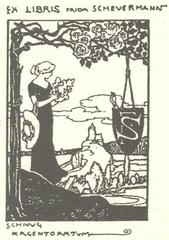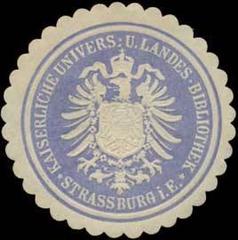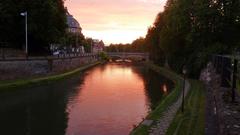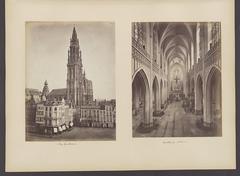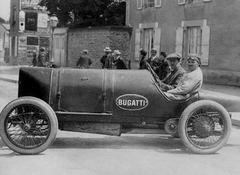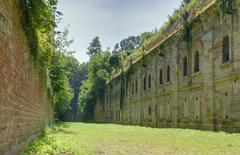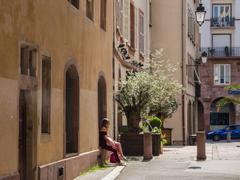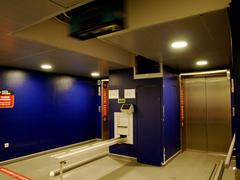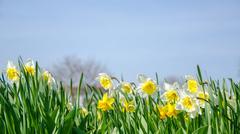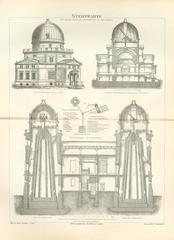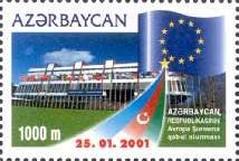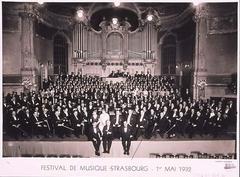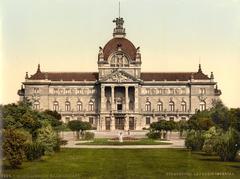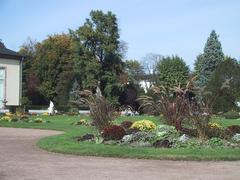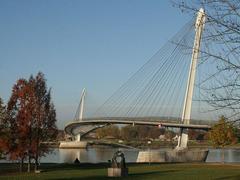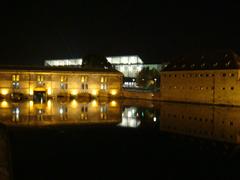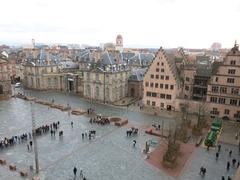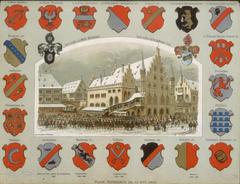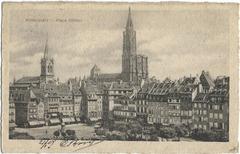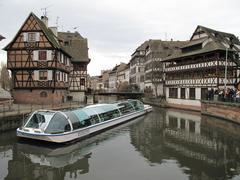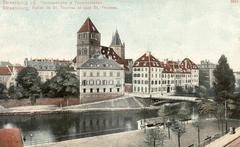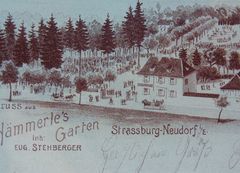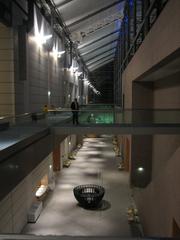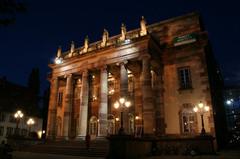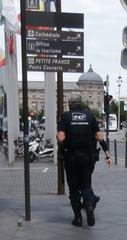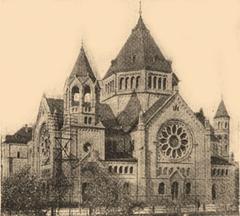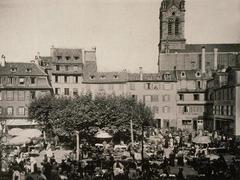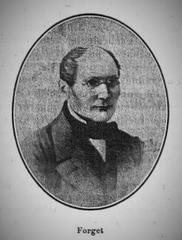
Saint-Nicolas Church Strasbourg: Visiting Hours, Tickets, and Historical Significance
Date: 04/07/2025
Introduction
Saint-Nicolas Church in Strasbourg stands as one of the city’s most treasured historical monuments, reflecting over eight centuries of religious, architectural, and cultural evolution. Located in the picturesque Krutenau district close to Strasbourg’s historic center, the church is notable for its harmonious blend of Romanesque, Gothic, and Baroque styles, its role in pivotal religious transformations, and its vibrant community life. This comprehensive guide provides everything you need to plan your visit, from opening hours and ticket information to a detailed exploration of the church’s history, architecture, and ongoing cultural significance (Strasbourg.eu; France-Voyage; Strasbourg Tourism).
Table of Contents
- Medieval Origins and Construction
- Religious Transformations and the Reformation
- Architectural Evolution and Restorations
- The French Revolution and 19th-Century Revival
- Albert Schweitzer and Musical Heritage
- Modern-Day Preservation and Heritage Status
- Visitor Information
- Notable Features and Artistic Heritage
- Community Role and Social Engagement
- Frequently Asked Questions (FAQs)
- Conclusion
- References
Medieval Origins and Construction
Saint-Nicolas Church traces its foundation to the 12th century, with records from 1182 marking its existence as a modest Romanesque church built to serve the expanding population of the then-suburban Krutenau district. By the late 13th century, a major Gothic expansion introduced pointed arches, ribbed vaults, and a soaring bell tower—elements that still define the church’s silhouette today (Strasbourg.eu; France-Voyage).
Religious Transformations and the Reformation
In the 16th century, Strasbourg emerged as a center for the Protestant Reformation. In 1529, the city’s adoption of Lutheranism led to Saint-Nicolas Church’s transition from Catholic to Protestant worship. This change prompted the removal of much of the Catholic iconography and the installation of a simple wooden pulpit, underscoring the Lutheran focus on preaching. Despite these reforms, the church maintained much of its original architecture and continued to serve as a gathering place for the local community (Strasbourg Tourism).
Architectural Evolution and Restorations
The church is a striking example of the Gothic hall church, with a nave and aisles of near-equal height, fostering a sense of openness. The bell tower, capped with a slender spire added in 1585, is a prominent feature of the city’s skyline (Monuments Historiques). The 18th century brought Baroque interior embellishments, which were later simplified in the 19th century. Notably, architect Eugène Petiti led significant restorations to reinforce the church’s medieval character. In 1905, architect Émile Salomon redesigned the façade and sacristy, integrating early 20th-century sensibilities with respect for the medieval core (Wikipedia FR).
The French Revolution and 19th-Century Revival
The French Revolution led to the secularization of the church and the loss of many religious artworks (Strasbourg Museums). With the Concordat of 1801, the church returned to religious use. Restoration efforts in the 19th century marked a renewed interest in preserving its historical and architectural value, leading to the reinstallation of several art pieces and ongoing conservation (Base Mérimée).
Albert Schweitzer and Musical Heritage
Between 1900 and 1913, Albert Schweitzer—renowned organist, theologian, and Nobel Peace Prize laureate—served at Saint-Nicolas Church, playing a pivotal role in reviving the music of Johann Sebastian Bach and overseeing the restoration of the historic Silbermann organ (Albert Schweitzer Foundation). Though the original 1707 Silbermann organ was removed in 1967, the church remains closely linked to Strasbourg’s rich musical tradition (Wikipedia EN).
Modern-Day Preservation and Heritage Status
Saint-Nicolas Church has been recognized as a protected historical monument since 1929 (Base Mérimée). Ongoing conservation projects ensure the preservation of its stained glass, stonework, and roofing. The church continues to serve as an active place of worship and a venue for concerts, exhibitions, and community events (Strasbourg Tourism).
Visitor Information
Opening Hours
- General Hours: Open daily from 9:00 AM to 6:00 PM.
- Exceptions: Hours may vary during religious services, holidays, or special events. Always verify on the official website before your visit.
Tickets and Admission
- Entry: Free of charge. Donations are welcomed to support ongoing maintenance and cultural programming.
Accessibility
- Mobility: Ramps and accessible entrances are available for visitors with reduced mobility. The open nave facilitates easy movement.
- Restrooms: Accessible restrooms are available; contact the church in advance for specific needs.
Guided Tours and Special Events
- Tours: Guided tours available on request or during peak tourist seasons; booking in advance is recommended.
- Events: The church hosts organ concerts, especially celebrating Albert Schweitzer’s legacy, and participates in citywide festivals such as the Strasbourg Christmas Market and European Heritage Days (European Heritage Days).
Getting There and Nearby Attractions
- Public Transport: Easily reached via tram lines B and F (stops: Krutenau, Finkwiller, or Porte de l’Hôpital); ample parking is available nearby.
- Nearby: Strasbourg Cathedral, Petite France, Saint-Thomas Church, Musée de l’Œuvre Notre-Dame, and Alsace Museum are all within walking distance (GPSmyCity).
Photography and Visitor Etiquette
- Photography: Permitted without flash or tripods to protect artworks. Please respect worshippers and avoid photography during services.
Notable Features and Artistic Heritage
- Architecture: Blends Romanesque origins with Gothic and Baroque enhancements; the tall bell tower and unified hall church plan are particularly noteworthy (France-Voyage).
- Medieval Frescoes: Fragments of 15th-century frescoes discovered during restoration work offer unique insights into medieval iconography.
- Renaissance Pulpit: Intricately carved woodwork reflects the transition from Gothic to Renaissance artistry (Musée Protestant).
- Stained Glass: 14th and 15th-century windows depict biblical scenes and local saints, adding color and narrative depth to the interior.
- Organ and Musical Heritage: Although the original Silbermann organ is no longer present, the church’s musical tradition continues with regular concerts and commemorations of Albert Schweitzer.
Community Role and Social Engagement
Saint-Nicolas Church remains a cornerstone of the Krutenau community. It hosts regular worship services for both Catholic and Protestant congregations, supports ecumenical and interfaith events, and organizes charitable programs such as food drives and refugee assistance (Communauté Saint Nicolas). The church is also central to local traditions during the feast of Saint Nicholas and the Strasbourg Christmas Market (Noël Alsace: Saint-Nicolas Events).
Frequently Asked Questions (FAQs)
What are the visiting hours of Saint-Nicolas Church?
Open daily from 9:00 AM to 6:00 PM; verify for holidays or special events.
Is there an entrance fee?
No, entry is free. Donations are appreciated.
Are guided tours available?
Yes, on request or through local tourist agencies, especially during peak seasons.
Is the church accessible for visitors with disabilities?
Yes, accessible entrances and restrooms are available. For specific needs, contact the church in advance.
Can I take photographs inside?
Yes, without flash or tripods, and with respect for worshippers.
How can I get there?
Tram lines B and F stop nearby; the church is within walking distance of major city attractions.
Conclusion
Saint-Nicolas Church is more than an architectural landmark; it is a living testament to Strasbourg’s spiritual, cultural, and artistic legacy. From its medieval foundations and Reformation role to its musical heritage and ongoing community engagement, the church invites visitors to experience layers of history in a welcoming and serene setting. With free entry, accessible facilities, and a central location, Saint-Nicolas is an essential stop for anyone exploring Strasbourg’s rich heritage. Plan your visit to enjoy the church’s art, music, and community spirit, and explore the surrounding historical sites for a deeper immersion into Alsatian culture.
References
- Saint-Nicolas Church Strasbourg: Visiting Hours, Tickets, and Historical Guide
- Visiting Saint-Nicolas Church Strasbourg: Hours, Tickets, History, and Artistic Highlights
- Strasbourg Tourism
- Monuments Historiques
- Strasbourg Museums
- Albert Schweitzer Foundation
- Wikipedia EN: Saint Nicholas Church, Strasbourg
- Musée Protestant
- Strasbourg Religious Heritage PDF
- Noël Alsace: Saint-Nicolas Events
- Communauté Saint Nicolas
- GPSmyCity: Historical Churches Walking Tour
- Wanderlog: Best Churches in Strasbourg




